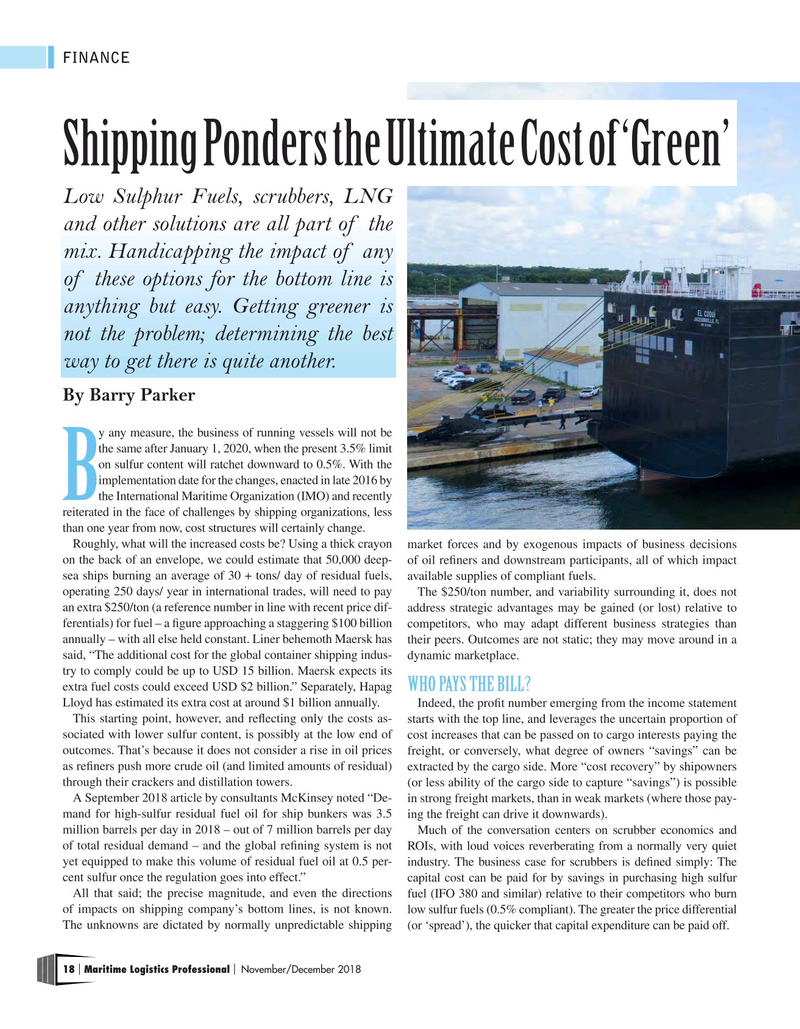
Page 18: of Maritime Logistics Professional Magazine (Nov/Dec 2018)
Regulatory & Environmental Review
Read this page in Pdf, Flash or Html5 edition of Nov/Dec 2018 Maritime Logistics Professional Magazine
FINANCE
Shipping Ponders the Ultimate Cost of ‘Green’
Low Sulphur Fuels, scrubbers, LNG and other solutions are all part of the mix. Handicapping the impact of any of these options for the bottom line is anything but easy. Getting greener is not the problem; determining the best way to get there is quite another.
By Barry Parker y any measure, the business of running vessels will not be the same after January 1, 2020, when the present 3.5% limit on sulfur content will ratchet downward to 0.5%. With the implementation date for the changes, enacted in late 2016 by
Bthe International Maritime Organization (IMO) and recently reiterated in the face of challenges by shipping organizations, less than one year from now, cost structures will certainly change.
Roughly, what will the increased costs be? Using a thick crayon market forces and by exogenous impacts of business decisions on the back of an envelope, we could estimate that 50,000 deep- of oil refners and downstream participants, all of which impact sea ships burning an average of 30 + tons/ day of residual fuels, available supplies of compliant fuels.
operating 250 days/ year in international trades, will need to pay The $250/ton number, and variability surrounding it, does not an extra $250/ton (a reference number in line with recent price dif- address strategic advantages may be gained (or lost) relative to ferentials) for fuel – a fgure approaching a staggering $100 billion competitors, who may adapt different business strategies than annually – with all else held constant. Liner behemoth Maersk has their peers. Outcomes are not static; they may move around in a said, “The additional cost for the global container shipping indus- dynamic marketplace.
try to comply could be up to USD 15 billion. Maersk expects its extra fuel costs could exceed USD $2 billion.” Separately, Hapag
WHO PAYS THE BILL?
Lloyd has estimated its extra cost at around $1 billion annually. Indeed, the proft number emerging from the income statement
This starting point, however, and refecting only the costs as- starts with the top line, and leverages the uncertain proportion of sociated with lower sulfur content, is possibly at the low end of cost increases that can be passed on to cargo interests paying the outcomes. That’s because it does not consider a rise in oil prices freight, or conversely, what degree of owners “savings” can be as refners push more crude oil (and limited amounts of residual) extracted by the cargo side. More “cost recovery” by shipowners through their crackers and distillation towers. (or less ability of the cargo side to capture “savings”) is possible
A September 2018 article by consultants McKinsey noted “De- in strong freight markets, than in weak markets (where those pay- mand for high-sulfur residual fuel oil for ship bunkers was 3.5 ing the freight can drive it downwards). million barrels per day in 2018 – out of 7 million barrels per day Much of the conversation centers on scrubber economics and of total residual demand – and the global refning system is not ROIs, with loud voices reverberating from a normally very quiet yet equipped to make this volume of residual fuel oil at 0.5 per- industry. The business case for scrubbers is defned simply: The cent sulfur once the regulation goes into effect.” capital cost can be paid for by savings in purchasing high sulfur
All that said; the precise magnitude, and even the directions fuel (IFO 380 and similar) relative to their competitors who burn of impacts on shipping company’s bottom lines, is not known. low sulfur fuels (0.5% compliant). The greater the price differential
The unknowns are dictated by normally unpredictable shipping (or ‘spread’), the quicker that capital expenditure can be paid off. 18 Maritime Logistics Professional November/December 2018 | |

 17
17

 19
19
